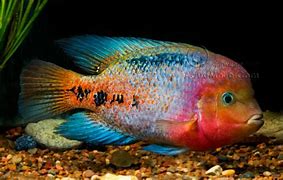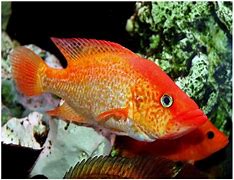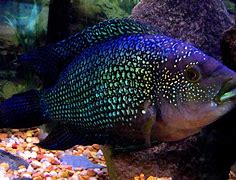North & Central American Cichlids
Quetzal Cichlid, Also known as the Redhead and Pastel Cichlid
Red Bay Snook
Jack Dempsey/Electric Blue Dempsey
Red Bay Snook
Jack Dempsey/Electric Blue Dempsey
Quetzal Cichlid, Also known as the Redhead and Pastel Cichlid
Other common names: Pastel Cichlid; Redhead Cichlid, Red Headed Cichlid
Size: 14 inches (36 cm.) in aquariums.
Scientific Name: vieja synspila Family- Cichlidae
Natural Habitat: The Vieja Syn originates from the Atlantic slope, in the Usumacinta river drainage in Mexico , Guatemala , and Belize
Description: The Quetzal (vieja synspila ) is probably one of the most colorful New World Cichlids with males displaying metallic green, blue, green, pink and orange along their sides.
Recommended Tank Size and Temperament:
Water Parameters: It does best with ph of 7.0-8.0 with a GH of 150-350 (dGH 9-20). It is a freshwater cichlid, but also has a slight tolerance to brackish water due to natural habitat of lakes and the lower river valley with some saline content. Temperatures of 77-82 are preferred.
Typical food: Basically a carnivore, so feeding frozen foods such as bloodworms as well as FD Plankton (small shrimp).
A high quality prepared carnivore diet such as Paradigm Premium Carnivore Diet is highly suggested.
I would also suggest gut loading of all live foods whenever possible to better replicate natural feeding which will also increase disease resistance.
Breeding: Spawning
Contributors Notes: By Bikeguy (from Everything Aquatic)
This is probably one of the parent species to the modern Blood Parrot and the Flower horn Cichlid. His temperament is peaceful to family, but can be aggressive with other smaller species. Form of reproduction is spawning, they are mid tank dwellers.
Size: 14 inches (36 cm.) in aquariums.
Scientific Name: vieja synspila Family- Cichlidae
Natural Habitat: The Vieja Syn originates from the Atlantic slope, in the Usumacinta river drainage in Mexico , Guatemala , and Belize
Description: The Quetzal (vieja synspila ) is probably one of the most colorful New World Cichlids with males displaying metallic green, blue, green, pink and orange along their sides.
Recommended Tank Size and Temperament:
Water Parameters: It does best with ph of 7.0-8.0 with a GH of 150-350 (dGH 9-20). It is a freshwater cichlid, but also has a slight tolerance to brackish water due to natural habitat of lakes and the lower river valley with some saline content. Temperatures of 77-82 are preferred.
Typical food: Basically a carnivore, so feeding frozen foods such as bloodworms as well as FD Plankton (small shrimp).
A high quality prepared carnivore diet such as Paradigm Premium Carnivore Diet is highly suggested.
I would also suggest gut loading of all live foods whenever possible to better replicate natural feeding which will also increase disease resistance.
Breeding: Spawning
Contributors Notes: By Bikeguy (from Everything Aquatic)
This is probably one of the parent species to the modern Blood Parrot and the Flower horn Cichlid. His temperament is peaceful to family, but can be aggressive with other smaller species. Form of reproduction is spawning, they are mid tank dwellers.
Red Bay Snook
Other common names: Bay Snook
Size: Males will grow to 18-21" (46- 53 cm.), females 10-14" (26– 36 cm.)
Scientific Name: Petenia splendida Family-Cichlidae
Natural Habitat: Mexico, Guatemala, Belize
Description:
Recommended Tank Size and Temperament: their temperament is mild unless you are 1/3 its body size or less. As they become extremely large when adults, 70 gallons and up is absolutely necessary
Water Parameters: Red Bay Snooks prefer temps of 77°F-86°F
Typical food: Red Bay Snooks will take, pellets, flake, worms, feeders....pretty much anything. In the wild they mostly feed on aquatic insects and fish.
Breeding: Spawning
Contributors Notes: By Bikeguy (from Everything Aquatic)
Now....in keeping this guy for 2 years, what I have seen is the most peace loving fish I have ever seen....he even sits mid tank at feeding to wait for the rest of my guys to eat and takes what’s left. This may have a lot to do with the fact he is a basket mouth.
For his teeth to catch you, he has to have you half swallowed....he has teeth in the back of his throat. His mouth has a thin membrane that extends 1/3 of his body length. It is actually quite a sight to see.
He is extremely rare in this hobby....partly because he gets so large. What he lacks in aggression, he makes up for in huge personality. He often gives the "I understand" look to his keeper.
Size: Males will grow to 18-21" (46- 53 cm.), females 10-14" (26– 36 cm.)
Scientific Name: Petenia splendida Family-Cichlidae
Natural Habitat: Mexico, Guatemala, Belize
Description:
Recommended Tank Size and Temperament: their temperament is mild unless you are 1/3 its body size or less. As they become extremely large when adults, 70 gallons and up is absolutely necessary
Water Parameters: Red Bay Snooks prefer temps of 77°F-86°F
Typical food: Red Bay Snooks will take, pellets, flake, worms, feeders....pretty much anything. In the wild they mostly feed on aquatic insects and fish.
Breeding: Spawning
Contributors Notes: By Bikeguy (from Everything Aquatic)
Now....in keeping this guy for 2 years, what I have seen is the most peace loving fish I have ever seen....he even sits mid tank at feeding to wait for the rest of my guys to eat and takes what’s left. This may have a lot to do with the fact he is a basket mouth.
For his teeth to catch you, he has to have you half swallowed....he has teeth in the back of his throat. His mouth has a thin membrane that extends 1/3 of his body length. It is actually quite a sight to see.
He is extremely rare in this hobby....partly because he gets so large. What he lacks in aggression, he makes up for in huge personality. He often gives the "I understand" look to his keeper.
Jack Dempsey/Electric Blue Dempsey
Other common names: Electric Blue Dempsey (Powder Blue Dempsey)
Size: Males up to 9-10 inches (23- 25 cm) while females are normally 6-8 inches (15- 20 cm).
Scientific Name: Cichlasoma octofasciatum, Archocentrus Octofasciatus Family-Cichlidae
Natural Habitat: A Central American Cichlid found in the Yucatan peninsula, Guatemala, Honduras. The Electric Blue is only captive bred, not a natural color and can command a very high price as compared to their wild brethren.
Description:
Recommended Tank Size and Temperament: An aggressive cichlid, Dempsey’s are best kept in tanks over 50 gallons and a minimum of 75 gallons plus is the general consensus among fish keepers for a breeding pair of Dempsey’s. In a mixed tank an even larger tank may be required (although I have kept 75 gallon mixed fish tanks that includes Dempsey’s).
Water Parameters: Very tolerant of wide difference in water conditions, as long as the conditions are stable. Generally speaking a pH of anywhere from 7.0 to 8.0 (as long as it does not swing within this range), a KH of 50-150, and a GH of 100 -250 (or even higher).
In fact it is the minerals found in GH such as Calcium, Magnesium, and more that are an essential for long term Jack Dempsey health that I have found in both observations and scientific research (see this article for more: Aquarium GH, KH, pH, Electrolytes). Stable temperatures between 70-80°F (21-27°C) are best for Dempsey’s.
Typical food: Jack Dempsey’s are omnivores.
Foods such as Paradigm Ultra Premium Omnivore Diet, Aqueon Cichlid Pellets, Spirulina Flakes (more for juveniles), FD Plankton (small shrimp), and frozen or live worms are a good mix for Jack Dempsey Cichlids
Breeding: The Jack Dempsey is a relatively easy cichlid to sex, with the male it will be larger and have longer more pointed fins with very little blue on the gill cover if any and will be in dots if its present. For the female, she will have flecks on her gill cover and have less color throughout the body.
Jack Dempsey’s are typical egg laying cichlids (not mouth breeders). The use of a clay pot, slate or similar gives a pair a good location to lay eggs, where the female will start laying her eggs as the male quickly follows up and fertilizes them. They will do this until all eggs have been laid and the female will begin to fan the eggs while the male stands guard outside the nesting perimeter. The eggs will hatch after about 3-4 days with the parents taking turns watching the nest using vertical displays and gill flaring to signal “changes in the guard”.
The fry will be transferred to a pit that has been dug by the parents where they both will stand guard, again taking turns. The young become free swimming after another several days after consuming the yolk sac in search of food in the form of powdered/crushed flake ( Spirulina 20 is excellent for this), baby brine shrimp, Micro Worms, etc. Particles of food left over from the parent’s meal will also be discovered and consumed by the young fry. It is generally advised to remove the young after they reach ½ inch in size.
Contributors Notes:
Size: Males up to 9-10 inches (23- 25 cm) while females are normally 6-8 inches (15- 20 cm).
Scientific Name: Cichlasoma octofasciatum, Archocentrus Octofasciatus Family-Cichlidae
Natural Habitat: A Central American Cichlid found in the Yucatan peninsula, Guatemala, Honduras. The Electric Blue is only captive bred, not a natural color and can command a very high price as compared to their wild brethren.
Description:
Recommended Tank Size and Temperament: An aggressive cichlid, Dempsey’s are best kept in tanks over 50 gallons and a minimum of 75 gallons plus is the general consensus among fish keepers for a breeding pair of Dempsey’s. In a mixed tank an even larger tank may be required (although I have kept 75 gallon mixed fish tanks that includes Dempsey’s).
Water Parameters: Very tolerant of wide difference in water conditions, as long as the conditions are stable. Generally speaking a pH of anywhere from 7.0 to 8.0 (as long as it does not swing within this range), a KH of 50-150, and a GH of 100 -250 (or even higher).
In fact it is the minerals found in GH such as Calcium, Magnesium, and more that are an essential for long term Jack Dempsey health that I have found in both observations and scientific research (see this article for more: Aquarium GH, KH, pH, Electrolytes). Stable temperatures between 70-80°F (21-27°C) are best for Dempsey’s.
Typical food: Jack Dempsey’s are omnivores.
Foods such as Paradigm Ultra Premium Omnivore Diet, Aqueon Cichlid Pellets, Spirulina Flakes (more for juveniles), FD Plankton (small shrimp), and frozen or live worms are a good mix for Jack Dempsey Cichlids
Breeding: The Jack Dempsey is a relatively easy cichlid to sex, with the male it will be larger and have longer more pointed fins with very little blue on the gill cover if any and will be in dots if its present. For the female, she will have flecks on her gill cover and have less color throughout the body.
Jack Dempsey’s are typical egg laying cichlids (not mouth breeders). The use of a clay pot, slate or similar gives a pair a good location to lay eggs, where the female will start laying her eggs as the male quickly follows up and fertilizes them. They will do this until all eggs have been laid and the female will begin to fan the eggs while the male stands guard outside the nesting perimeter. The eggs will hatch after about 3-4 days with the parents taking turns watching the nest using vertical displays and gill flaring to signal “changes in the guard”.
The fry will be transferred to a pit that has been dug by the parents where they both will stand guard, again taking turns. The young become free swimming after another several days after consuming the yolk sac in search of food in the form of powdered/crushed flake ( Spirulina 20 is excellent for this), baby brine shrimp, Micro Worms, etc. Particles of food left over from the parent’s meal will also be discovered and consumed by the young fry. It is generally advised to remove the young after they reach ½ inch in size.
Contributors Notes:



